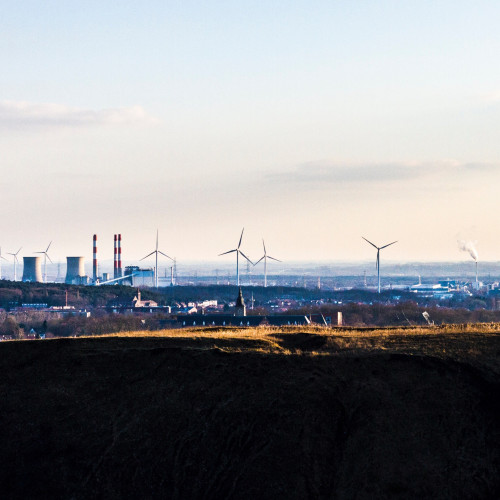Tim Yeo, New Nuclear Watch Institute
The message loud and clear from COP26 is that the world is finally moving towards cleaner energy. Even louder and clearer is the message is that it is moving far too slowly.
Without a drastic acceleration of this progress there is no chance whatever of keeping the rise in average surface temperature below 2C. Every country must come to COP27 in Egypt next autumn with a revised Nationally Determined Contribution which is compatible with 2C.
Even more importantly these NDCs can’t just be a target to be achieved decades hence after today’s leaders retire. Each one must be backed up by a detailed practical plan setting out the actions which will be taken to achieve that target.
This is no small challenge. Historically only two countries have ever cut their fossil fuel consumption as fast as every country must now do if dangerous irreversible climate change is to be prevented.
France and Sweden showed the way back in the 1970s in the wake of the first oil shock. Both did so by investing heavily in a rapid increase in nuclear energy capacity.
Of course half a century ago, nobody foresaw the possibility of plentiful renewable energy. Nor did they anticipate a time when using the abundant reserves of coal, oil and gas would threaten the conditions of climate stability on which the enormous economic advances and population growth of the last two hundred years have been based.
The other key message from COP26 is that keeping the temperature rise below 2C is a task which can’t be left to the 2030s and 2040s. To achieve this goal we must start now and make substantial progress in this decade.
No technical problem prevents this from happening. The technology to decarbonise almost entirely two of the highest emitting industries – electricity generation and surface transport – already exists. All that’s needed to begin tomorrow is the political will to do so.
Decarbonising surface transport depends heavily on electricity so the most urgent task is to end the use of coal and gas for electricity production. This requires massive expansion of renewable energy capacity, mainly solar and wind power because most of the best potential hydro-electric resources are already being exploited.
But it is already clear that relying too heavily on intermittent sources of energy compromises the ability of any nation to maintain that continuous supply of electricity on which modern business and social life depends.
This is why the renaissance of nuclear energy is so critical. It provides the reliable baseload power needed to complement renewables.
Furthermore the development of advanced and small modular reactors will enable nuclear to reach new locations unsuitable for large plants. Floating nuclear plants will add more flexibility.
Beyond COP26 we need universal acceptance of the key contribution which nuclear can make to overcoming climate change, a halt to all fossil fuel exploration, faster closure of all coal fired power stations and early phaseout of all unabated gas plants.
Nothing less than this will ensure humanity’s survival.
Judi Greenwald, Nuclear Innovation Alliance
For two weeks, world leaders and climate activists gathered in the United Kingdom to tackle one of the world’s greatest challenges: climate change. At the eleventh hour, COP26 concluded with the Glasgow Climate Pact, a success for participating countries and an indication of sustained international interest in achieving our climate goals. Through the pact, member states agreed to accelerate progress towards addressing climate change by introducing new and more aggressive emission and temperature targets. Most notably, new pledges were made on methane gas pollution control and deforestation, and COP26 called for an end to fossil fuel subsidies -- all significant steps towards limiting global warming to the 1.5-2.0 degree Celsius threshold established by The Paris Agreement in 2015.
Historically, nuclear energy has not been well represented at COP, even though it is carbon- free. This changed at COP26, where nuclear energy finally became a key part of these important climate discussions.
As the world works to address climate change, it is increasingly apparent how nuclear energy can play a key role in achieving human prosperity while also protecting the planet. Nuclear energy allows member states to incorporate Sustainable Development Goals into domestic agendas without sacrificing economic opportunity. In a report released before COP26, the IAEA detailed how nuclear technology can provide greenhouse gas- free electricity and also be used as a part of a “climate-smart” agricultural and water management system. For example, some member states struggle to obtain ready access to clean water; certain radionuclides can be used to develop water saving technologies. Additionally, advanced nuclear technology can power desalination plants to tackle water insecurity. All these applications are enabled by the development of national nuclear energy programs and infrastructure, as well as global support, investment, and cooperation in the development of advanced nuclear energy technologies and regulatory frameworks.
This is the message that experts and activists attending COP26 shared with world leaders to ensure that nuclear energy plays a key role in the climate solution moving forward. By harnessing the power of nuclear energy, countries will be able to power cities and rural communities using clean, carbon-free energy, decarbonize industrial processes, and sustain high-quality jobs and thriving communities.
Moving forward from COP26, the Nuclear Innovation Alliance and others in the nuclear energy community are taking steps to include the nuclear energy community in international climate and energy development conversations. At COP26, Nucala Power and the Romanian national nuclear company Nuclearelectrica announced an agreement to construct a NuScale small modular reactor plant by 2028. Similarly, countries like South Africa identified nuclear energy as an attractive option to help phase down their existing coal reliance as advanced nuclear power plants can be sited at retired coal plants and utilize certain existing infrastructure.
NIA sees an emerging narrative taking hold on the global stage that recognizes the inherent and potential advantages of nuclear energy as a complement to other clean and renewable energy sources in combating climate change and driving sustainable global development. At future COP summits and other international engagements, nuclear energy deserves a seat at the table for the sake of humanity and the environment.
Luc Van Den Durpel, Nuclear-21
The world is facing tremendous challenges induced by humankind’s unsustainable environmental practices. Economic development, especially over the past 50 years, has come with far too much greenhouse-gas emissions, emissions that have already led to significant challenges, with much more destabilising consequences to be expected if we fail to decarbonise quickly and effectively.
Shining a spotlight on all potential scenarios of environmental upheaval, COP26 was meant to be a platform for discussing the most suitable policies to optimally reduce, and better yet, mitigate the consequences of out-of-control emissions. But, yet again, we saw science-based approaches jeopardised by the ideological agendas of certain participants. At the same time, we saw that many countries are taking a systematic view on these challenges and increasingly embracing a science-backed long-term approach while promoting an effective and achievable path towards decarbonisation, rather than a path constrained by ideology.
Let nuclear energy be the game-changer between ineffective and inefficient approaches and those that achieve our environmental goals using minimal natural resources, money, expertise, thereby preserving these resources for use for other important societal needs.
While the increased societal and political enjoyed by nuclear energy in many countries is a positive development, the international financial market, which is increasingly integrating environmental, social, and governance (ESG) criteria in its decision-making, remains a crucial source of support. Our current task is, therefore, to ensure the appropriate positioning of nuclear energy in ESG investment portfolios.
This will require the nuclear energy community to clearly communicate how its accomplishments today will translate into tangible and bankable options tomorrow, to effectively handle intranuclear challenges (such as increasing the effectiveness of newbuild projects, improving radioactive waste disposal techniques, etc.), and to be coherent on its prime objectives (i.e., further improving LWR-designs, making SMRs workable in multiple energy markets, advancing nuclear for beyond 2050, etc.).
The coming decade is crucial for nuclear energy. We will either fail to provide the planet with sustainable solutions or make them happen. We cannot afford to dilute our message and need to act efficiently to secure both existing and newbuild projects, all the while transitioning towards more integrated nuclear energy systems and providing tangible solutions to meet societal needs.
Martin Porter, World Nuclear Transport Institute
COP26 was seen as an opportunity to place new nuclear technologies within the green energy mix in the global drive to deliver decarbonisation and limit global warming to 1.5C. At the opening address session, the Prime Minister of Barbados, Mia Mottley, delivered an impassioned call to world leaders to consider all nations and work together to ensure that the threat of global warming and rising sea levels was mitigated as best it could. Within the address Ms Mottley called for three phases of response - Voices, Ambitions and Actions. The voice of nuclear was loud, proud and prominent at COP26, no more so than the ‘net zero needs nuclear’ messaging so ably championed by the Young Generation Network and its collaborators. The sentiment of this messaging was also at the forefront of COP26 interventions made by the International Atomic Energy Agency, the International Maritime Organisation, the World Nuclear Association, the New Nuclear Watch Institute, the World Institute of Nuclear Security and the World Nuclear Transport Institute as well as many others. It cannot be denied that the voice of nuclear, in both energy and propulsion, presented an articulate and compelling argument but we need to now hold the mirror up and ask ourselves ‘so what next?’. Clearly, if we follow Ms Mottley’s mantra then we need to consider our ambitions and our future actions.
It may be said that our ambitions are clear and captured in the ‘net zero needs nuclear’ message, but what does that mean? New nuclear energy generation technologies are evolving at speed and this was made even clearer when the UK SMR Consortium, led by Rolls Royce, announced that a government/private funding deal had been secured, this being broadcast during the second week of COP26. There has also been significant progress in developing fusion as a civil energy source whilst a number of entities are exploring the potential for nuclear to be used to generate green fuels such as hydrogen and ammonia. All in all, there is much optimism and opportunity for a nuclear energy renaissance. Alongside this, molten salt reactors and other technologies provide similar opportunities in providing a nuclear maritime propulsion energy source. Collectively, these technological innovations provide us with an industry ambition to modernise the nuclear portfolio and contribute to the global efforts in constraining warming through decarbonisation.
So what actions are required to realise our ambitions?
COP26 demonstrated to the world the synergy that exists within the nuclear community. The power of collaboration, when policy makers and non-governmental organisations work together, was palpable and clearly generated substantial energy. This collaborative ethos must be preserved in order to deliver the necessary actions without gap or overlap. COP26 was not finite in so much as we cannot fool ourselves that it came and went. The voice that was clearly so loud at COP26 needs to be sustained, and arguably increased, in order to deliver the necessary actions and outcomes. It is nowhere near a foregone conclusion that nuclear will join renewables in the future configuration of energy and propulsion, that will only be realised if the power of the nuclear lobby is maintained until such time as there is a global will to accept nuclear as a sustainable, green contributor to carbon reduction. As Ms Mottley so eloquently directed the COP26, Voices, Ambitions, Actions.







